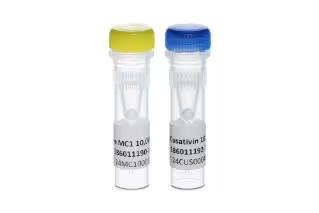RapiZyme RNases
Tunable RNA digestion for streamlined LC-MS sequencing
CRISPR sgRNA and mRNA require vigorous characterization to confirm their identity, sequences, and purity. These RNA molecules are prime candidates for LC-MS analysis due to their complex functionality, modifications, and variants present. Because of their size, digestion with an endonuclease such as an RNase is often performed prior to injection. The resulting digestion products can be readily detected using ion pairing reversed phase (IPRP) or hydrophilic chromatography (HILIC) coupled with mass spectrometry (MS).
Waters RapiZyme MC1 and RapiZyme Cusativin offer controlled, reproducible RNA cleavage at a range of dinucleotide sites. RapiZyme RNases produce a variety of unique RNA fragments with complementary overlap. For LC-MS users, this gives tunable digestions that improve confidence in peak identifications with a result to increase sequence coverage and molecular insights. Each tube includes 10,000 units of RapiZyme RNase, which is enough enzyme reagent to complete up to 100 digestion reactions of 10 µg RNA samples.
- Achieve maximum sequence coverage for mRNA and sgRNA
- Work with RNases specifically designed for LC-MS analysis
- Eliminate the need for denaturants and RNases inhibitors when performing digestion
- Achieve cleaner signal and sensitivity with cyclic phosphate products
- Accelerate the development and analysis of RNA therapeutics
Specifications
Overview
- Enhance results with more complete sequence coverage for LC-MS characterization of RNA
- Improve efficiency with high purity, highly active enzyme reagents up to 100 reactions depending on substrate
- Simplify your analysis using a ready-to-automate protocol for digestion
- Avoid over digestion and instrument/column contamination with reliable heat inactivation that does not require additional inhibitor reagents
- Target uridine or cytidine residues using two enzymatic specificities
- Maximize sensitivity and simplify data interpretation with enzyme digestion properties integrated within waters_connect MAP Sequence
- Pair with IonHance HFIP mobile phase additive for a 2x decrease in unwanted sodium and potassium adducts
Recommended Use: For improved sequence coverage for CRISPR sgRNA and mRNA therapeutics.
A quest to digest
RapiZyme MC1 and RapiZyme Cusativin have reproducible cleavage specificities. Double labeled, quenched RNA substrates have been applied to study RapiZyme MC1, and RapiZyme Cusativin. Upon cleavage by the RNase, a FAM-labeled test substrate is separated from its Black Hole Quencher conjugate. The digest event is then detected using absorbance-based techniques providing a quantitative measurement for on-target cleavage. A negative control, HEX-labeled substrate (e.g. polyA) is additionally applied to evaluate the off-target cleavage. The ratio of FAM/HEX provides insights into the activity of each enzyme and can be performed under various conditions including temperature, pH, buffer composition, enzyme units, and time. These analyses were performed to determine the optimal reaction conditions for RapiZyme Cusativin and RapiZyme MC1.
Let’s get specific
RapiZyme MC1 and RapiZyme Cusativin are high purity, highly active RNases that offer complementary cleavage specificities. These recombinant, tunable enzymes are designed to accelerate the development and analysis of RNA therapeutics by facilitating controlled digestion of synthetic oligonucleotides, mRNA, and sgRNA. RapiZyme MC1 exhibits its most selective, efficient digestion rates at [A/U/C]pU dinucleotide bonds at pH 8, while RapiZyme Cusativin cleaves most efficiently and selectively at Cp[U/A/G] dinucleotide sequences at pH 9. Parameters such as temperature, pH, and enzyme to substrate ratio may be altered to optimize for sample specific effects.
Cover your bases
RapiZyme MC1 and RapiZyme Cusativin exhibit a preference for substrate docking and cleavage at specific dinucleotide locations. RapiZyme MC1 has a tendency for cleaving at the 5’ end of uridine and RapiZyme Cusativin at the 3’ end of cytidine. Both enzymes demonstrate controlled, repeatable cleavage products. The idiosyncratic nature of these RNases results in partial digestion, generating longer products in addition to unique and overlapping fragments. Partial digestion, providing a plethora of information, creates more diverse fragments to investigate for structural elucidation. Data interpretation can be expedited with informatics tools such as waters_connect MAP Sequence, which predicts in silico fragments (mRNA Cleaver) based on the known cleavage properties of the chosen enzyme and maps the observed data to the sequence of the RNA molecule being investigated.
